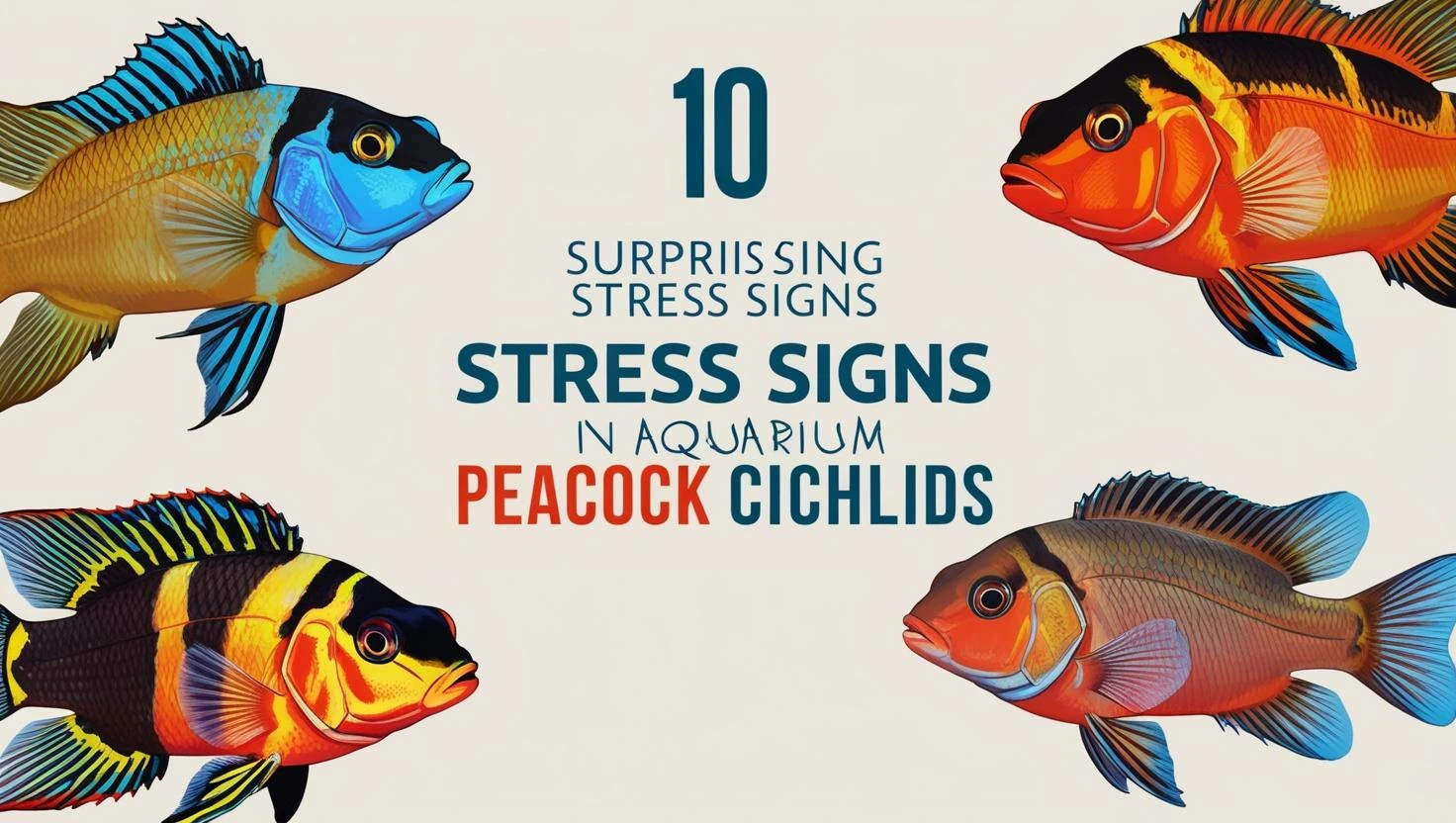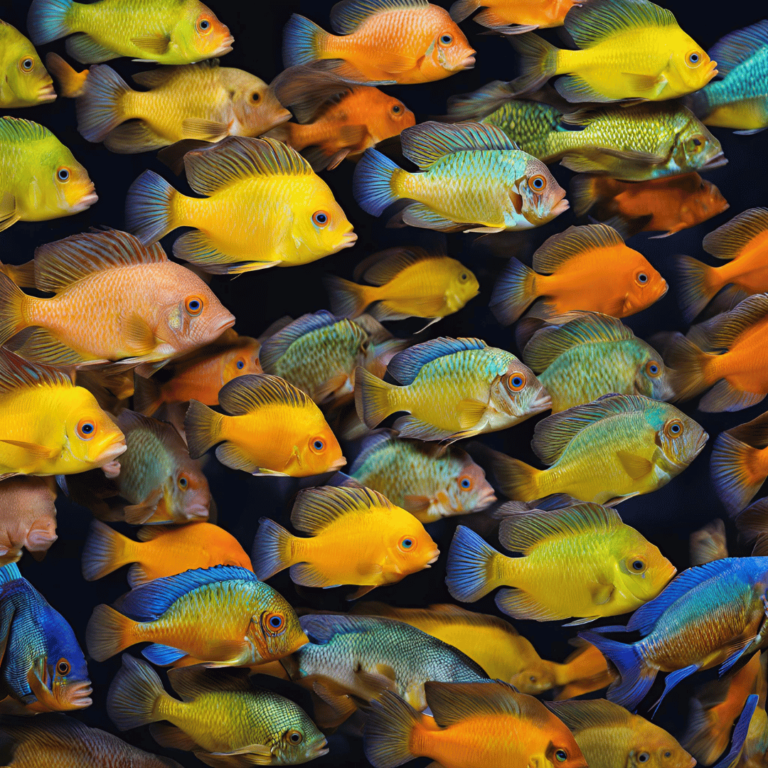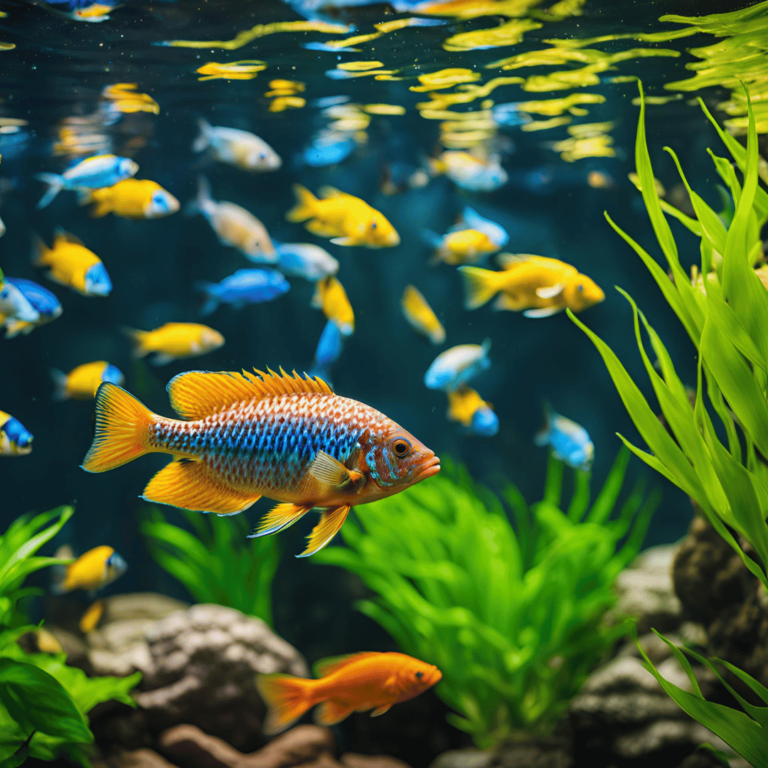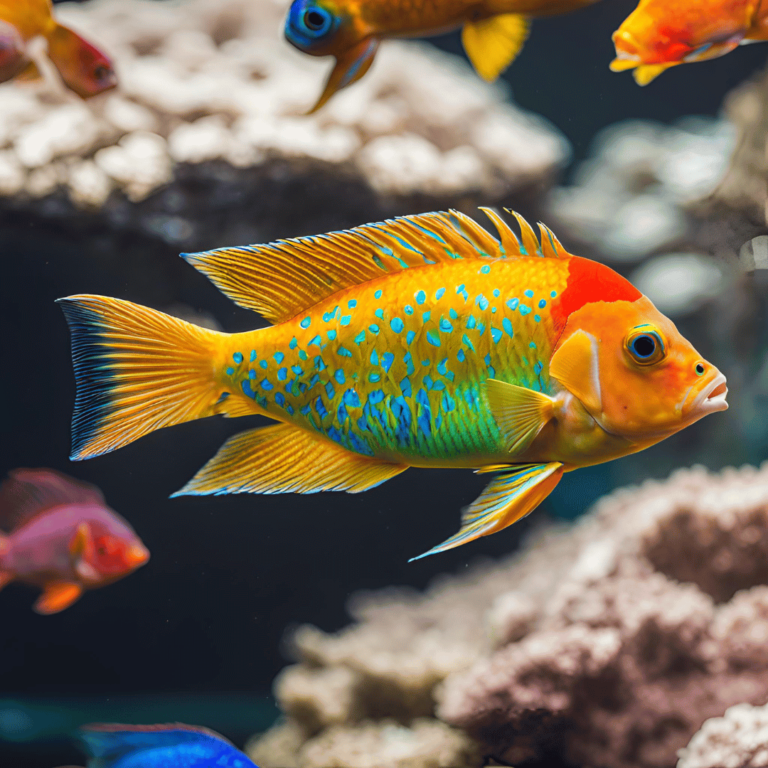Your trusted guide to cichlid care, tank setups, and quality products.

10 Surprising Peacock Cichlid Stress Signs in Aquarium Behavior?!!
Image Credits Canva
Peacock cichlids captivate aquarists with their brilliant hues and dynamic personalities. However, even these vibrant fish can experience stress, and recognizing the subtle Peacock Cichlid Stress Signs early on is essential for maintaining a healthy aquarium. In this comprehensive guide, we explore 10 surprising Peacock Cichlid Stress Signs and provide actionable tips to help you keep your aquatic friends thriving.
Understanding Peacock Cichlid Behavior & Stress: Key Peacock Cichlid Stress Signs
Before diving into the specific Peacock Cichlid Stress Signs, it’s important to understand the natural behavior and stress responses of these fascinating fish. Native to the rivers of South America, peacock cichlids are known for their active behavior and vivid colors. However, environmental changes, dietary issues, and social conflicts can trigger stress, leading to a variety of subtle yet critical Peacock Cichlid Stress Signs.
Early detection of these signs is crucial. By observing changes in behavior, appearance, or interactions with tank mates, you can intervene promptly to prevent long-term health issues. Let’s explore the 10 most surprising Peacock Cichlid Stress Signs that every aquarist should be aware of.
1. Changes in Coloration: A Telltale Peacock Cichlid Stress Sign
One of the most striking Peacock Cichlid Stress Signs is a noticeable change in coloration. Peacock cichlids are celebrated for their brilliant hues, so any fading or dullness is a red flag.
- What to Observe:
Look for signs of washed-out colors, unusual patches, or overall color fading. These changes often indicate that the fish is stressed, possibly due to poor water quality or health issues. - Why It Matters:
Color changes are among the earliest Peacock Cichlid Stress Signs. They suggest that the fish’s immune system might be compromised, making it more vulnerable to infections. - Action Tip:
Regularly test your water parameters using a high-quality water testing kit. Maintaining optimal pH and nutrient levels can help keep your cichlids vibrant and healthy.
2. Erratic Swimming Patterns: A Dynamic Peacock Cichlid Stress Sign
Erratic swimming is another clear Peacock Cichlid Stress Signs that should not be ignored. When your peacock cichlid begins to swim erratically or appear disoriented, it is signaling distress.
- What to Observe:
Watch for sudden, uncontrolled movements, rapid darting across the tank, or a noticeable inability to settle in one spot. - Possible Causes:
Erratic swimming can result from stress due to temperature fluctuations, overcrowding, or compromised water quality. - Action Tip:
Check your aquarium’s filtration system and ensure the temperature remains stable. Consider using an aquarium heater or cooling device if needed.
3. Loss of Appetite: A Critical Peacock Cichlid Stress Sign
A sudden loss of appetite is a classic Peacock Cichlid Stress Signs. Healthy peacock cichlids are usually eager to feed, so any reluctance or disinterest in food is a cause for concern.
- What to Observe:
Notice if your cichlid skips meals or shows less interest during feeding times. - Possible Causes:
Stress from environmental changes, poor water conditions, or even aggressive tank mates can lead to decreased appetite. - Action Tip:
Evaluate your feeding routine and the quality of your fish food. Supplementing with nutrient-rich food can help your cichlid regain its appetite and energy.
4. Excessive Hiding or Isolation: A Subtle Peacock Cichlid Stress Sign
Peacock cichlids are typically active and social. However, if you notice your fish spending an unusual amount of time hiding or isolating itself, it is exhibiting an important Peacock Cichlid Stress Signs.
- What to Observe:
Look for increased hiding behind decorations or corners of the tank, or a reluctance to interact with other fish. - Possible Causes:
Stress may be triggered by aggressive tank mates, sudden changes in the tank layout, or environmental discomfort. - Action Tip:
Enhance your tank with plenty of hiding spots and visual barriers. This can help reduce stress and give your fish a sense of security.
5. Aggressive Displays: An Alarming Peacock Cichlid Stress Sign
While some aggression is normal among peacock cichlids, a sudden surge in aggressive behavior is a strong Peacock Cichlid Stress Signs.
- What to Observe:
Take note of any unprovoked attacks, excessive chasing, or territorial disputes that deviate from typical behavior. - Possible Causes:
Overcrowding, incompatible tank mates, or insufficient hiding spaces can elevate stress and trigger aggressive interactions. - Action Tip:
Reassess your tank’s social dynamics. Adding more decor or adjusting the number of fish in the tank can help alleviate stress-induced aggression.
6. Frayed or Damaged Fins: A Visible Peacock Cichlid Stress Sign
Healthy, intact fins are crucial for proper swimming and overall vitality. Frayed or damaged fins are a clear Peacock Cichlid Stress Signs indicating physical stress or injury.
- What to Observe:
Examine your fish for torn, frayed, or discolored fins, which can be a sign of stress, aggression, or physical injury. - Possible Causes:
Poor water quality, aggressive encounters with other fish, or sharp objects in the tank can result in fin damage. - Action Tip:
Regularly inspect your aquarium for hazards and ensure proper maintenance. Using water conditioners can help promote healing and maintain optimal fin health.
7. Lethargy or Inactivity: A Subtle Behavioral Peacock Cichlid Stress Sign
A peacock cichlid that becomes lethargic or inactive is displaying an important Peacock Cichlid Stress Signs. These active fish should normally be energetic and engaged.
- What to Observe:
Notice if your cichlid spends extended periods resting, appears sluggish, or shows a lack of interest in its surroundings. - Possible Causes:
Inactivity can be linked to poor nutrition, suboptimal water conditions, or underlying illnesses that sap the fish’s vitality. - Action Tip:
Ensure your aquarium’s water is clean and well-oxygenated. Consistent monitoring of water quality and regular maintenance can help restore normal activity levels.
8. Rapid Breathing or Gasping: A Critical Peacock Cichlid Stress Sign
Rapid breathing or gasping at the water’s surface is one of the most urgent Peacock Cichlid Stress Signs. This behavior should prompt immediate attention.
- What to Observe:
Keep an eye out for frequent surface visits, gulping of air, or visibly labored breathing. - Possible Causes:
This symptom can indicate low oxygen levels, poor water quality, or even the onset of an infection. - Action Tip:
Verify that your tank is well-aerated by checking your air pump or increasing water agitation. Conduct an immediate water test to confirm that oxygen and toxin levels are within safe ranges.
9. Unusual Social Interactions: A Behavioral Peacock Cichlid Stress Sign
Changes in the social behavior of your peacock cichlids can be a subtle but significant Peacock Cichlid Stress Signs.
- What to Observe:
Look for alterations in how your fish interact with each other—whether it’s increased shyness, unwarranted aggression, or avoidance of certain tank mates. - Possible Causes:
Environmental stress, disease, or disruptions in the established social hierarchy can all lead to abnormal social behaviors. - Action Tip:
Monitor the dynamics of your tank closely. Adjustments like reconfiguring tank decor or temporarily separating aggressive individuals can help reduce stress.
10. Increased Susceptibility to Disease: The Ultimate Peacock Cichlid Stress Sign
A weakened immune system, leading to an increased susceptibility to disease, is perhaps the most serious Peacock Cichlid Stress Signs.
- What to Observe:
Frequent infections, lesions, or any signs of illness are clear indicators that stress is undermining your fish’s health. - Possible Causes:
Chronic stress from poor water quality, nutritional deficiencies, or prolonged exposure to stressors can weaken your cichlid’s immune defenses. - Action Tip:
Focus on preventive measures: maintain pristine water conditions, ensure a balanced diet, and conduct regular health check-ups. Early intervention is key to preventing minor issues from escalating.
Potential Causes of Peacock Cichlid Stress Signs
Understanding the root causes of these Peacock Cichlid Stress Signs is crucial for effective intervention. Here are some common factors that can trigger stress in your aquarium:
- Environmental Factors:
Poor water quality, unstable temperatures, overcrowding, and inadequate tank setup can all lead to stress. Even slight deviations in water parameters can trigger multiple Peacock Cichlid Stress Signs. - Social Dynamics:
Incompatible tank mates, territorial disputes, and a lack of hiding spaces can exacerbate stress. A well-planned tank layout that considers the social needs of peacock cichlids can help minimize these issues. - Dietary Concerns:
Inconsistent feeding schedules, low-quality food, or sudden dietary changes can result in nutritional stress, which in turn manifests as various Peacock Cichlid Stress Signs. - Maintenance Issues:
Neglecting regular tank maintenance can lead to toxin buildup and deteriorating water quality, further contributing to stress. Regular cleaning and water changes are essential to keep your aquarium safe and healthy.
How to Manage and Reduce Peacock Cichlid Stress Signs
Managing Peacock Cichlid Stress Signs requires a multi-faceted approach that addresses both the environment and the fish’s behavior. Here are some effective strategies:
- Optimize the Aquarium Environment:
- Water Quality: Regularly test and maintain water parameters. Invest in reliable filtration systems and water conditioners to ensure a balanced environment.
- Temperature Control: Keep your tank’s temperature stable using quality heaters or coolers.
- Tank Setup: Provide ample hiding spots and decor to create distinct territories and reduce stress from overcrowding.
- Improve Social Conditions:
- Compatible Tank Mates: Select tank mates that are known to coexist peacefully with peacock cichlids.
- Balanced Social Structure: Regularly monitor fish interactions and be ready to rearrange the tank or separate aggressive individuals to ease stress.
- Enhance Nutritional Health:
- High-Quality Diet: Feed your peacock cichlids a varied and nutrient-rich diet to support their immune systems and overall vitality.
- Consistent Feeding Routine: Maintain a steady feeding schedule to prevent nutritional stress that can lead to adverse Peacock Cichlid Stress Signs.
- Regular Maintenance & Monitoring:
- Routine Cleaning: Keep your aquarium clean with regular water changes and substrate cleaning.
- Health Check-ups: Stay vigilant and monitor your fish for any early Peacock Cichlid Stress Signs. Prompt action can help prevent small issues from becoming major problems.
- Stress-Relief Products:
- Utilize water conditioners, supplements, and other aquarium accessories recommended by experts to further minimize stress. These products can be a valuable addition to your routine care.
Conclusion
Recognizing Peacock Cichlid Stress Signs is key to ensuring that your aquarium remains a vibrant and healthy habitat for your fish. From changes in coloration and erratic swimming to unusual social interactions and increased disease susceptibility, each sign is a signal that your peacock cichlids need attention. By understanding the causes and implementing the strategies discussed above, you can reduce stress and promote a balanced, thriving environment.
If you enjoyed this guide and want to dive even deeper into the world of peacock cichlid care, be sure to check out our related articles on peacockcichlid.com.
Explore expert insights in articles like 7 Proven Tips to Reduce Peacock Cichlid Aggression in Tanks, Peacock Cichlid Care: 7 Powerful Tips for Beginners, and Peacock Cichlid Tank Maintenance: 14 Proven Tips for Success for more ways to keep your aquarium vibrant and stress-free. You can also find valuable advice in our posts on 7 Expert Tips to Maintain Water Quality for Peacock Cichlids and Peacock Cichlid Tank Setup: 10 Expert Tips for a Stunning Setup.
We invite you to visit peacockcichlid.com regularly for the latest tips and updates, and don’t forget to follow us on social media for even more expert advice and community support!
FAQ’s
What are the primary Peacock Cichlid Stress Signs to watch for?
The primary Peacock Cichlid Stress Signs include changes in coloration, erratic swimming patterns, loss of appetite, excessive hiding or isolation, increased aggression, fin damage, lethargy, rapid breathing, unusual social interactions, and heightened susceptibility to diseases. Keeping an eye on these indicators can help you detect early signs of distress in your fish.
Why is it important to recognize Peacock Cichlid Stress Signs early?
Recognizing Peacock Cichlid Stress Signs early is crucial because early detection allows you to adjust water quality, improve tank conditions, and modify feeding routines before the stress leads to severe health issues. Early intervention helps maintain a vibrant and healthy aquarium environment.
How does a change in coloration serve as a Peacock Cichlid Stress Sign?
A change in coloration is one of the most visible Peacock Cichlid Stress Signs. When a normally vibrant peacock cichlid starts displaying dull or washed-out colors, it can be an indicator that the fish is under stress due to poor water conditions, illness, or other environmental factors.
What water quality issues can trigger Peacock Cichlid Stress Signs?
Water quality issues such as unstable pH, high ammonia or nitrate levels, low oxygen concentration, and temperature fluctuations are common causes of Peacock Cichlid Stress Signs. Regular water testing and maintenance are essential to prevent these stress triggers.
Can erratic swimming be considered a reliable Peacock Cichlid Stress Sign?
Yes, erratic swimming is a reliable Peacock Cichlid Stress Signs. When a fish displays rapid darting, disoriented movements, or an inability to settle, it often indicates that environmental stressors like temperature swings or overcrowding are affecting its well-being.
How do social dynamics in the tank relate to Peacock Cichlid Stress Signs?
Social dynamics play a significant role in the health of peacock cichlids. Incompatible tank mates, overcrowding, or aggressive behavior can all contribute to Peacock Cichlid Stress Signs. A balanced social structure with plenty of hiding spaces helps reduce these stress factors.
Why does loss of appetite indicate Peacock Cichlid Stress Signs?
Loss of appetite is a common Peacock Cichlid Stress Signs because stressed fish often lose interest in food. A sudden decline in feeding behavior can be linked to environmental stressors or health issues, making it essential to reassess the fish’s habitat and dietary routine.
What preventative measures can help reduce Peacock Cichlid Stress Signs?
Preventative measures include regular water quality checks, maintaining a stable tank temperature, providing a balanced diet, ensuring proper tank maintenance, and creating ample hiding spots. These steps address common Peacock Cichlid Stress Signs and help create a stress-free environment for your fish.
Is rapid breathing considered one of the most urgent Peacock Cichlid Stress Signs?
Absolutely. Rapid breathing or gasping at the surface is one of the most urgent Peacock Cichlid Stress Signs. It can indicate low oxygen levels or severe water quality issues, requiring immediate action to adjust aeration and water conditions.
How can fin damage be interpreted as a Peacock Cichlid Stress Sign?
Fin damage, such as torn or frayed fins, is a clear Peacock Cichlid Stress Signs. This type of physical injury may result from aggressive interactions with tank mates or from environmental hazards. Regular tank inspections and careful monitoring of water quality can help prevent such issues.



